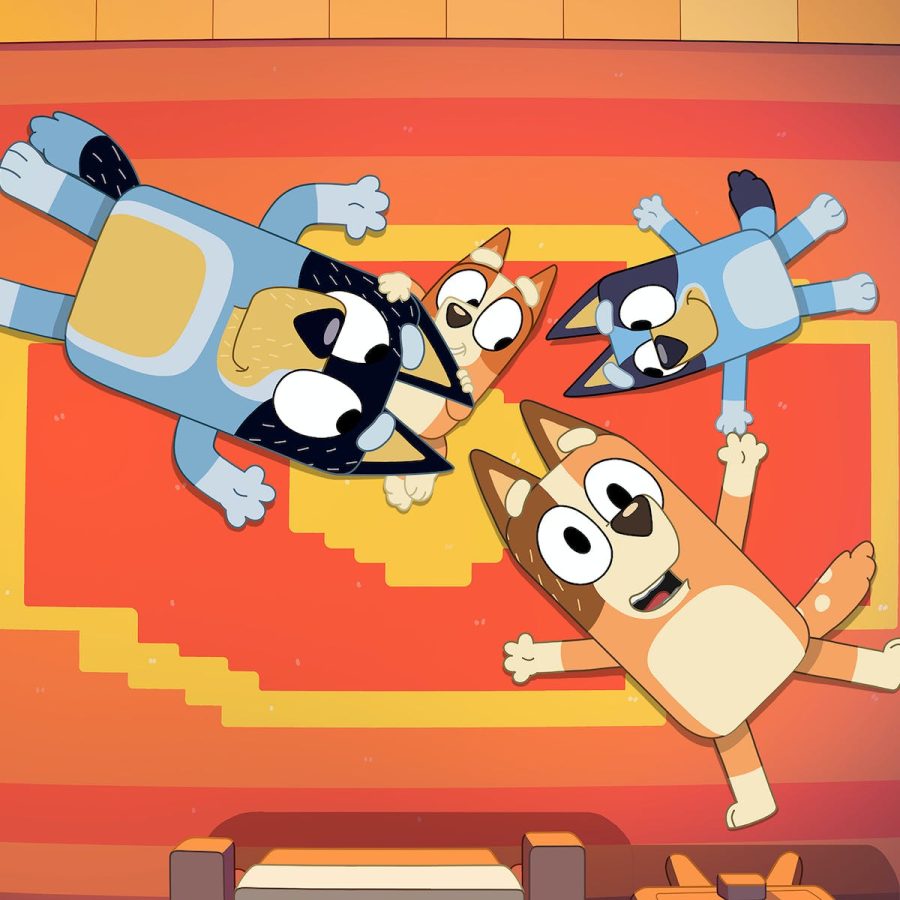Why So Many are Watching Bluey, and Why You Should, Too
January 18, 2023
I’m a seventeen-year-old high school student trapped in the terrifying expanse of the information age, worrying about college, work, and my future. My generation and I are facing skyrocketing debt, workforce automation, decomposition of social support systems, and the creeping effects of climate change, complemented by a liberal sprinkling of record depression and anxiety rates among teens. So why am I watching an Australian kids’ show about a blue cartoon puppy playing pretend? And why am I not alone in this?
In December 2022, Joe Brumm’s Bluey reached #1 on Disney Plus’ trending list, as well as being named the most-streamed show of the year in Australia where it originally aired. Despite the show being primarily aimed at preschoolers, this little blue heeler dog and her family have captured the hearts of hundreds of millions across the globe from all ages and demographics, but it seems not many are talking about it.
With the simple premise of a four-person (or in this case, four-dog) family navigating the world around them, we watch as Bluey and her sister Bingo discover the joys of life and imagination as they are guided by their loving parents Bandit and Chilli. The Mum and Dad in this show are wonderful highlights for any older viewers, as their characters are simultaneously soulful and hilarious. Each character is realistic, layered, and joyfully distinctive, sharing complex interpersonal dynamics and genuine love for those in their lives.
There’s something so refreshing and uncommon about this kind of sincerity.
While the show typically follows a “problem-of-the-week” format, each episode explores a new aspect of one or more of its characters so that you grow to adore each member of the Heeler family as your familiarity with them increases. Many episodes touch on and tactfully handle complicated issues such as death, aging, parenthood, trauma, stress, learning disabilities, pregnancy complications, and more. Each 5-10 minute episode is uniquely enchanting and never leaves you without a brighter, more hopeful outlook on life than you had before.
While every episode is engaging and fun, some episodes such as Sleepytime, Camping, Flat Pack, Baby Race, Daddy Dropoff, Rain, Grandad, and Curry Quest have stood out to audiences as exceptionally meaningful and poignant, and even tear-jerking at times.
At first glance, these episodes have simple themes that help children deal with issues like sharing, keeping promises, and respecting their loved ones, but beneath these premises exist many complex and inspiring layers of meaning.
For example, Daddy Dropoff seems like a small message about why it’s important to play, but older audiences are likely to pick up on some deeper themes such as the duties of parenthood, finding patience with children, learning about the humanity in your parents, teaching by example to make someone’s day brighter, and the incredible ripple effects of patience, love, playfulness, and respect. Without spoiling the episode, Bluey shows (rather than tells) how one small act of love can change a person’s entire life.
This was the first episode to make me tear up.
Rated the #8 TV show episode of any show ever on IMDb, Sleepytime is a metaphor for the love shared by family, and the overwhelming and all-consuming love a mother has for her child. In its seven and a half minutes, Joe Brumm crafts a story no other writer on earth could. Without going into any detail, Flatpack is a metaphor for life, the human condition, and existence itself.
I could analyze this stuff for hours, but I don’t want to spoil the experience for new viewers, and many have already done so. Podcasts, news articles, and analysis videos abound breaking down the writing of these episodes which resemble short films more than they do children’s programming.
This show would not have the same emotional impact without its score. The soundtrack of Bluey is, hands down, one of my favorite TV scores, let alone to come from children’s programming. In Bluey the Album, composer Joff Bush goes above and beyond to create a fun, peaceful, and whimsical ambiance, with some specific personal favorites being Creek is Beautiful!, The Wagon Ride, and The Weekend alongside the album’s only vocal track, I Know a Place (The Creek Song) by Helena Czajka and Jazz D’Arcy. Accompanied by the fantastic visual style of art director Costa Kassab, the Bluey watching experience is truly unique in the way it beams with simple youth and joy.
I’m glad to see it getting more attention in the U.S. in recent months, even going so far as to receive a balloon in Macy’s Thanksgiving Day Parade. Bluey has now secured itself as one of my favorite shows across the board, but if someone told me last month that this would be the case, I’d have never believed them. Maybe soon you will be able to say the same?



